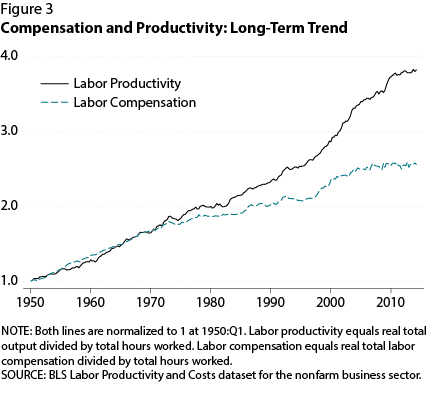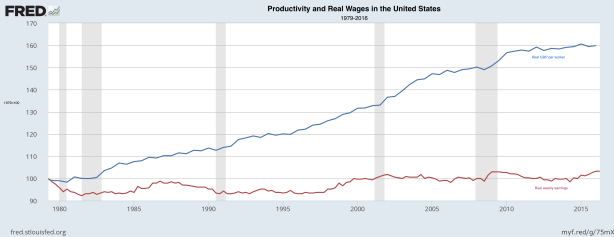From David Ruccio According to the norms of both neoclassical economic theory and capitalism itself, workers’ wages should increase at roughly the same rate as their productivity.* Clearly, in recent years they have not. The chart above, which was produced by B. Ravikumar and Lin Shao for the Federal Reserve Bank of St. Louis, shows that labor compensation has grown slowly during the recovery of the U.S. economy from the 2007-09 recession. In fact, real labor compensation per hour in the nonfarm business sector was 0.5 percent lower 20 quarters after the start of the recovery, while labor productivity had increased by 6 percent. Clearly, the gap between worker compensation and productivity has grown during the current recovery. But the authors go even further, showing that the gap in the United States between compensation to workers and their productivity has been growing for decades. labor productivity has been growing at a higher rate than labor compensation for more than 40 years. As Figure 3 shows, labor productivity in 2016:Q1 is 3.8 times as high as that in 1950:Q1; labor compensation, on the other hand, is only 2.7 times as high. In other words, the gap between labor productivity and compensation has been widening for the past four decades.
Topics:
David F. Ruccio considers the following as important: Uncategorized
This could be interesting, too:
tom writes The Ukraine war and Europe’s deepening march of folly
Stavros Mavroudeas writes CfP of Marxist Macroeconomic Modelling workgroup – 18th WAPE Forum, Istanbul August 6-8, 2025
Lars Pålsson Syll writes The pretence-of-knowledge syndrome
Dean Baker writes Crypto and Donald Trump’s strategic baseball card reserve
from David Ruccio

According to the norms of both neoclassical economic theory and capitalism itself, workers’ wages should increase at roughly the same rate as their productivity.* Clearly, in recent years they have not.
The chart above, which was produced by B. Ravikumar and Lin Shao for the Federal Reserve Bank of St. Louis, shows that labor compensation has grown slowly during the recovery of the U.S. economy from the 2007-09 recession. In fact, real labor compensation per hour in the nonfarm business sector was 0.5 percent lower 20 quarters after the start of the recovery, while labor productivity had increased by 6 percent.
Clearly, the gap between worker compensation and productivity has grown during the current recovery.

But the authors go even further, showing that the gap in the United States between compensation to workers and their productivity has been growing for decades.
labor productivity has been growing at a higher rate than labor compensation for more than 40 years. As Figure 3 shows, labor productivity in 2016:Q1 is 3.8 times as high as that in 1950:Q1; labor compensation, on the other hand, is only 2.7 times as high. In other words, the gap between labor productivity and compensation has been widening for the past four decades. The slower growth in labor compensation relative to labor productivity during the recovery from the two most recent recessions is part of this long-term trend. (reference omitted)
The data in Figure 3 show that the productivity-compensation gap—defined as labor productivity divided by labor compensation—has been increasing on average by approximately 0.9 percent per year since 1970:Q1. Based on this long-term trend, the gap would have been 51 percent higher in 2016:Q1 compared with 1970:Q1; in the data, the gap is actually 47 percent higher.
The fact is, labor compensation has failed to keep up with labor productivity after the Great Recession. But, as it turns out, there’s nothing unique about this period. The gap has been growing for more than four decades in the United States.**
Clearly, the recent and long-term trends of productivity and labor compensation challenge the norms of neoclassical economics and of capitalism itself. But we are also seeing the growth of another gap—between the promises of both neoclassical theory and capitalism and the reality workers have faced for decades now.
*Neoclassical economics—in particular, the marginal productivity theory of distribution—is based on the idea that the factors of production (land, labor, capital, and so on) receive in the form of income what they contribute to production. So, for example, as labor productivity increases, real wages should also rise. Similarly, capitalism is based on the idea of “just deserts.” That idea—that everyone gets what they deserve—is essential to the very idea of fairness or justice in the way the economy is currently organized.
**The authors’ analysis is based on the gap between labor compensation and productivity. If we look at real wages (as in the chart below) instead of compensation (which includes benefits, and therefore the portion of the surplus employers distribute to pension plans, healthcare insurers, and others), the gap is even larger.
According to my calculations from Fed data, since 1979, productivity has grown by 60 percent while real wages have increased by less than 5 percent.

